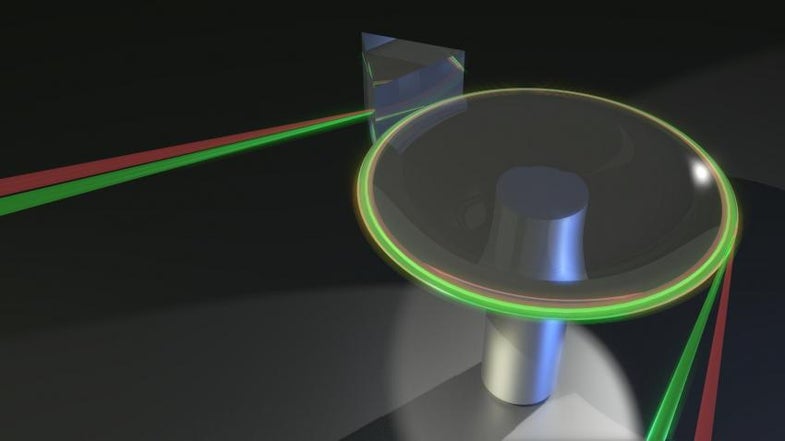How It Works: An Ultra-Precise Thermometer Made From Light
This isn't your average thermometer.

The world’s most sensitive room-temperature thermometer uses two colors of light to measure temperature with a precision of 30 billionths of a degree. This kind of precision far exceeds that of regular medical or home thermometers that we come into contact with.
It all started when University of Adelaide professor Andre Luiten and Ph.D. candidate Wenle Weng encountered a problem while trying to stabilize fluctuating laser frequencies—small changes in temperature of a device in their experiment was disrupting results—so they sought to detect the temperature change and suppress it, as detailed in their paper. The device was a resonator, used to generate waves of a specific frequency, and crucial to the experiment. Luiten suggested the idea of sending two colors of lasers into the resonator and measuring the differences in frequency, and calculating the change in temperature. Light of different colors travels at different speeds in the same material, and that difference depends on the temperature of the material.
Here’s how it works:
- Choose a dual-frequency laser that produces different colored light—in this case, it’s infrared light and a green light. The colors chosen by the team depended on the availability of specific lasers in the lab. According to Weng, however, optimal color choices can improve the thermometer sensitivity even more.
- Beam the laser at your resonator, which is a crystalline disk. The crystalline materials (calcium fluoride and magnesium fluoride) were chosen for their transparent nature, which means light suffers the least loss when traveling inside these materials. The less light loss, the more accurate the measurements.
- The green and red light travels around the disk thousands of times—similar to the phenomenon known as a “whispering gallery,” where sound waves cling to circular walls and allow whispered communication to be heard anywhere along the internal circumference. In this case, light waves are circulating the edge of the disk in the same way.
- Measure the difference in the frequencies (equivalent to the travel speed) of the two colors and use the known relationship between temperature fluctuation and light frequency to calculate the temperature. Luiten notes that the experiment reveals “the minute fluctuations that occur in even a perfectly temperature-stabilized environment.”
The unconventional light thermometer is currently the most sensitive thermometer that exists, if you’re working at room temperature—three times more precise than the previous best. The team did note that it’s possible to make thermometers more sensitive if you’re using them at very cold temperatures. High-precision measurement of temperature change in biological interactions or chemical reactions at extremely small scales can help identify exactly what’s happening in the reaction. The thermometer may also find applications in medical studies and materials engineering.